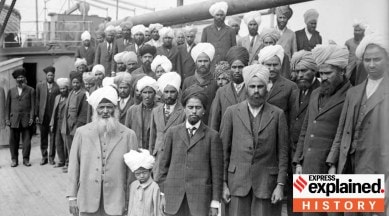How the Sikh migration to Canada began
The ongoing tussle between New Delhi and Ottawa has brought the Sikh diaspora in Canada under the spotlight. Currently, Canada is home to the largest Sikh population outside India and Sikhs have been arriving there for more than a century.

Canadian Prime Minister Justin Trudeau on Friday (September 22) said his government shared with India evidence of “credible allegations” about the involvement of Indian agents in the killing of the pro-Khalistan leader Hardeep Singh Nijjar many weeks ago.
A diplomatic stand-off erupted between Canada and India on Tuesday (September 19) after Trudeau alleged a “potential link” between the Indian government and the killing of Nijjar in Canada earlier this year. In response, New Delhi accused Ottawa of sheltering “Khalistani terrorists and extremists”.
The fallout once again brought the Sikh diaspora in Canada under the spotlight. According to the 2021 Canadian census, Sikhs account for 2.1% of the country’s population. Moreover, Canada is home to the largest Sikh population outside India.
The numbers don’t come as a surprise, though. For over a century, Sikhs have been migrating to Canada. Why did Sikhs start to move to Canada? Who were the first Sikhs to arrive in the country? What challenges did they face?
The arrival
Sikhs began to migrate overseas in the late 19th century as they were involved in the armed services for the British Empire, Gurharpal Singh, an emeritus professor at the University of London’s School of Oriental and African Studies, told The New Yorker magazine.
“Wherever the Empire expanded, especially in the Far East—China, Singapore, Fiji, and Malaysia—and East Africa, that’s where the Sikhs went,” Singh said.
Sikhs’ arrival in Canada began with Queen Victoria’s Diamond Jubilee in 1897. Kesur Singh, a Risaldar Major in the British India Army (25th Cavalry, Frontier Force), is considered the first Sikh settler to come to the country that year. He was amongst the first group of Sikh soldiers who arrived in Vancouver as part of the Hong Kong Regiment, which included Chinese and Japanese soldiers en route to celebrate the jubilee.
The first wave of Sikh migration to Canada, however, was triggered in the initial years of the 1900s. Most of the migrant Sikhs moved to the country as labourers — logging in British Columbia and manufacturing in Ontario.
“The original immigration was small, a little over 5,000, and made up of men looking for overseas employment but not intent on settling. The immigrants were classic sojourners, intent on staying no more than three to five years and on remitting home as much of their savings as possible,” according to the ‘Encyclopedia of Diasporas: Immigrant and Refugee Cultures Around the World’, edited by Melvin Ember, Carol R Ember, and Ian Skoggard.
The pushback
Although the migrants easily found work, they encountered hostility based on the perception that they were taking away jobs from localities. Not only this, the Sikhs also faced racial and cultural prejudices. The situation kept deteriorating as more and more Sikhs arrived in the country.
With the mounting public pressure, the Canadian government finally put an end to the migration by introducing stringent regulations. It made it mandatory for Asian immigrants to possess a “sum of $200, considered high enough to serve as a distinctive, and to arrive in Canada only by means of a continuous journey from their country of origin,” Nalini Kant Jha wrote in her article, ‘The Indian Diaspora in Canada: Looking Back and Ahead’ (India Quarterly, January-March, 2005, Vol 61).
As a result, immigration from India into Canada declined drastically after 1908, from 2,500 during 1907-08, to only a few dozen per year, she added.
It was during this time the Komagata Maru incident took place. In 1914, a Japanese steamship, known as Komagata Maru, reached the shores of Vancouver. It was carrying 376 South Asian passengers, most of whom were Sikhs. The immigrants were detained onboard the ship for about two months, and then escorted out of Canadian waters, sending it back to Asia.
According to the Canadian Museum of Human Rights, once the ship arrived in India, an altercation between British authorities and the passengers broke out. When the altercation ended, “22 people were dead, including 16 passengers,” it added.
The turnaround
The Canadian immigration policy relaxed after the end of World War II. It happened for three main reasons.
First, it became difficult for Canada to maintain an immigration policy and practice based on racial preferences after it joined the United Nations and its declaration against racial discrimination, and membership in a multi-racial Commonwealth of equal partners, according to Jha.
Second, post WWII, Canada started to expand its economy for which it required labourers.
Third, there was a “decline in the immigration of people from Europe and the Canadian government turned to the third world countries for ‘the import of human capital,’” Paramjit S Judge, professor and head of the Department of Sociology at Guru Nanak Dev University, Amritsar, wrote in his 2003 article, ‘Social Construction of Identity in a Multicultural State: Sikhs in Canada’, published in the Economic & Political Weekly magazine.
The factors ultimately led to the introduction of the ‘points system’ in 1967 by the Canadian government that made skill alone as criteria for admission of non-dependent relatives into the country and eliminated any preferences given to one particular race.